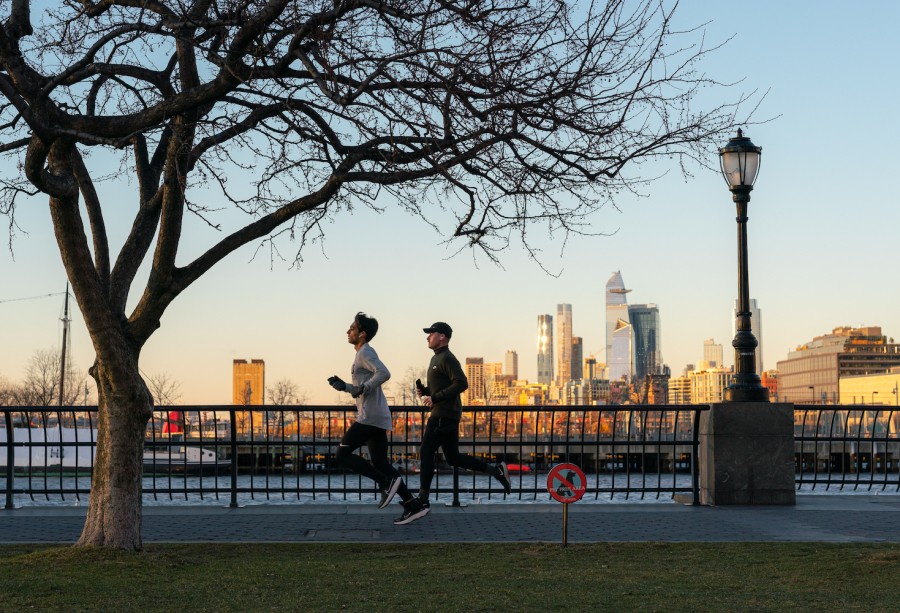4 tips for running in New York City
New York City is one of the most runner-friendly cities in the country — if you know how to navigate it.
(Augustin Langlet for WSN)
March 3, 2023
With its packed sidewalks, populous crowds and overall clutter, Manhattan may seem like a completely un-runnable borough. But if you’re willing to call New York a walkable city, then you might as well call it runnable, too. During my time at NYU, I’ve trained for two half-marathons, and I can confidently say that running in lower Manhattan is both doable and enjoyable if you take the right steps to prepare. If you’re looking to get out there and run as the weather warms up, here’s a list of tips and how-tos for running around Manhattan.
Get to know the grid
Know where you are and which direction you’re facing at all times. While this may seem obvious, I’ve found that visualizing my position on a map of New York City makes my runs around NYU much easier. I plan almost all of my runs around two parks in lower Manhattan: the East River Park and the Hudson River Park along the West Side Highway. These coastal parks are hot spots for runners, bikers and dog-walkers. They’re great for cardio-goers, as once you actually get to the park, you don’t need to worry about navigating the streets of the city.
Run streets, not avenues
To get to these parks, you have to travel either east or west, depending on which one you want to visit. These directions require running on streets instead of avenues, a large part of why I like running to East River Park and the West Side Highway. Avenues are littered with tourists and commercial shops, while streets tend to be more residential. From my experience, the best places to run in the city are the streets occupied by residential buildings, my favorite being the brownstones in the West Village.
While running in the city, I’m always paying attention to the flow of traffic. Many of the streets in New York City are one-way, so use this to your advantage. Usually, cars drive east to west on even-numbered streets, and vice versa on the odd-numbered streets. Sometimes on empty one-way streets, I run directly down the center facing opposite the flow of traffic. That way, I don’t bother the people on the sidewalks, and I can spot an oncoming car with enough time to move to safety. I’ve also tried running against traffic in bike lanes, but with the traffic of cyclists, this lane can be dangerous. The more you run, the more you’ll figure out the general flow of both traffic and the city as a whole.
Always be aware of your surroundings
My first few months of running in the city were done without headphones to reduce sensory distractions. Once I understood the flow and traffic of the area, however, I started running with headphones, although I make sure I have the volume down low and use my headphones’ transparent setting. Regardless of whether I’m listening to music, I always take my phone with me when I am running. One of my greatest running investments was buying a running pouch that fits my phone and other running necessities — I personally use an SPIbelt. Another tip: A good way to hold onto a house key is to tie it into your shoelaces.
Sometimes I run when it’s dark out, although I usually try to avoid it. If I do end up running in the dark, I often avoid the parks since they’re often empty and poorly lit. My runs in the dark are shorter than daytime runs, and sometimes I run down avenues instead of my preferred streets so that I’m around more people. I prefer Eighth and Tenth Avenues for my night runs because they’re separated from the rush of Fifth Avenue but still have plenty of people.
I never run somewhere at night if I haven’t been there during the day. When running, be it during the day or at night, use your judgment as well as your street smarts. This means never running close to buildings when you’re running around a corner, and if you’re running parallel to someone, always run behind them.
Plan your runs wisely
Part of running in New York City is accepting that you’ll always be around other people — but, if you know your neighborhood well, you can figure out the ebb and flow of the crowd. The East Village is a good place to run when it’s empty at 9 a.m. on a Saturday, but by 2 p.m., there are so many people that you’re likely better off somewhere else. The more you explore your neighborhood, the more you’ll know what times are suitable for running and what times aren’t.
When I do end up running during a busier time of day, there are a few rules I try to follow. If I’m stuck in a crowd, I’ll stop running until I get out of it. I never jog in place at the stop lights, and I always apologize if I accidentally bump someone’s shoulder. You don’t have to feel self-conscious about running in New York City because no one is paying attention to what you’re doing.
When I run, I try to set an intention. Sometimes the goal of my run is to feel fit and fast, but other times my run is just a way to shake off anxiety, to process something that’s bothering me or to give my brain a break. Whatever the reason is, running should be enjoyable. Running has been a great way for me to explore Manhattan, and with these tips, I hope running can be a way for you, too, to experience the city this spring.
Contact Tahra Khanuja at [email protected].
























































































































































